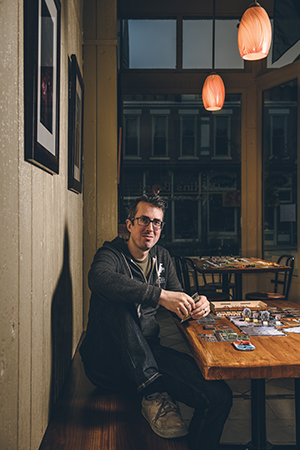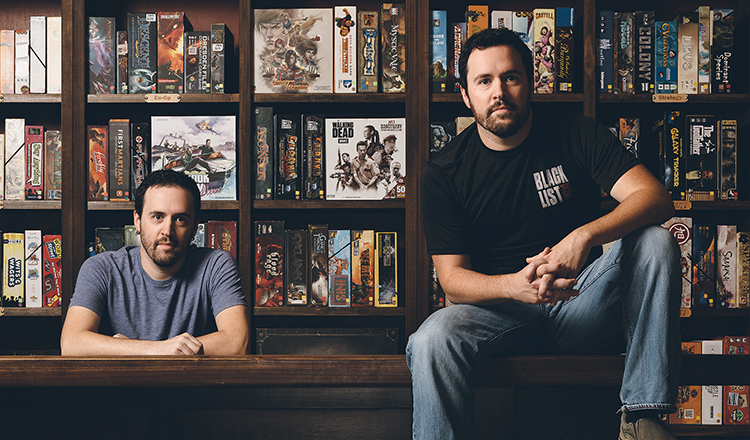Meet the Boilermakers behind some of tabletop gaming’s hottest titles
Sir Ragnar had been found. He was alive but badly hurt. The wizard only needed to escort the injured knight back to the staircase where the rest of the rescue party was waiting. Suddenly, an alarm sounded throughout the dungeon. Ulag, the Orc Warlord, and his minions began attacking. Ragnar was killed in the melee. The heroes had failed.
It was all a bit too much for then-9-year-old Brady Sadler (LA’09), who vividly remembers breaking down and crying after the defeat.
“HeroQuest taught me how powerful board games can be,” Brady says. “As a kid, it was so dramatic. We were the good guys. We were supposed to win. Reflecting on that, on how invested I was in that story and how the game created such an emotional response, it’s just a really great reminder of how board games can immerse you in another world.”
Brady and his twin brother, Adam (LA’10), spent hours playing the massively popular adventure board game with their mom, Elaine (Gilbert) Scott (LA’78), acting as the evil wizard game master, Zargon. HeroQuest, released in the US by Milton Bradley in 1990, featured four characters — a barbarian, a dwarf, an elf, and a wizard — who battled monsters while searching for treasure and completing quests, such as the rescue of Sir Ragnar. The game introduced the young Sadler brothers to cooperative role-play gaming.
“It was one of the first popular dungeon-crawling board games,” Adam says. “It was the first game we played that had really detailed miniatures and plastic furniture — bookshelves, treasure chests, torture devices — combined with storytelling elements and the ability to write your own quests. It created a really cool environment to play in.”
Now rising game designers in their own right, the Sadler brothers recognize the influence HeroQuest had on their own life paths. In high school and college, the brothers performed in a fantasy metal band called Lorenguard, Adam on bass and Brady on drums. The band members dressed in costume, personifications of the fictional backstory Brady was writing. It was his first foray into world building.
At Purdue, Brady majored in creative writing, Adam in fine arts with a focus on drawing and illustration. Both landed a jobs with Fantasy Flight Games upon graduation — Brady as a copywriter and Adam as a game producer — where Adam was the lead designer on the board game Descent: Journeys in the Dark Second Edition. They left Fantasy Flight and moved back to Indiana to pursue game design on a freelance basis, ensuring more creative control.
When they’re designing together, the Sadlers begin with a central theme and collaborate to develop concepts around that theme. When it comes to mocking up a game for play testing, Adam typically focuses on player experience while Brady develops the old-school equivalent of artificial intelligence — how the game reacts to challenge players in response to certain actions such as meeting objectives.
“At the same time, we have to make sure those aspects complement each other,” Brady says. “So we’ll swap roles and contribute ideas here and there. It’s all collective and collaborative. Basically every creative endeavor we’ve ever done, we’ve done as a team anyway.”
Warhammer Quest: The Adventure Card Game, their first big co-design as freelancers for Fantasy Flight, sold out in its initial printing. Other Sadler brothers designs under the Fantasy Flight label include Star Wars: X-Wing, The Walking Dead: No Sanctuary, and Heroes of Terrinoth. The brothers were tapped by Blacklist Games, a startup publisher based in Austin, Texas, to design the crossover worlds of Street Masters, inspired by 1990s street fighter video games, and Brook City, inspired by 1980s action movies.
“We did an expansion for Street Masters called Twin Tiger, which is a play on Double Dragon, an old Nintendo game that featured twin martial artists,” Adam says. “They said, ‘Let’s just put you guys in there as the twins.’ So now we’re the faces of Axel and Rhys.”
Their next big project is the Street Masters: Aftershock expansion, which met its Kickstarter goal in nine hours, soaring to $422,647. Crowdfunding has fueled the board game boom. Kickstarter saw 400 more successful campaigns for tabletop games in 2017 than in the previous year, and revenue was up 30 percent. According to market research firm NPD Group Inc., US sales of board games in 2017 hit $1.1 billion. An estimated 5,000 new games are released annually.
“Kickstarter changed the industry in a big way,” Adam says. “So many people can make games now when they couldn’t get financed before. You don’t have to go through a traditional publisher anymore. If you have a good idea, you can get other people to back it for you.”
Like HeroQuest, the majority of the games the brothers design are theme-driven cooperative games that create an engaging narrative experience for the players.
“Our creative process is driven by collaborative game mechanics,” Brady says. “It’s always circling around how players work together to overcome obstacles. You’re all collectively playing against the game. Win or lose, it’s a shared experience.”
Top of His Game
Issac Childres is going to need a bigger kitchen table. The nondescript oak oval is blanketed with game pieces, some professionally manufactured, others crudely drafted on run-of-the-mill copy paper. It’s evidence of the latest expansions in development for Gloomhaven, his massively popular cooperative dungeon crawler that took the board game industry by storm. Gloomhaven has sold 120,000 copies and is in its fourth printing of 80,000. The initial Kickstarter in 2015 pulled in $386,000 from almost 5,000 backers, far surpassing the $70,000 goal and gaining an immediate cult following. Those devotees hyped the game so much, stores immediately sold out of the additional 2,200 copies shipped to retailers worldwide, leaving almost 25,000 unfulfilled preorders.

“That was kind of unprecedented,” says Childres (PhD S’14). “My distribution broker had never seen anything like it before. I knew Gloomhaven was going to be big when it started getting shipped out to reviewers and they were very excited about it, posting to Twitter and to gaming forums. There was all this buzz building before it even came out.”
A second Kickstarter campaign raised almost $4 million from 40,600 backers. Gloomhaven rocketed to No. 1 on the boardgamegeek.com rankings in December 2017 — months before it was available in stores — a position it’s held for the past year. The ginormous game takes an estimated 150 hours to play through nearly 100 scenarios. Inside the 20-pound box, you’ll find scads of components: detailed miniatures, hundreds of monsters, multiple card decks (it has more than 1,700 individual cards), board overlay tiles, tokens, and stickers, but you won’t find any dice.
“I’m a control freak,” Childres says. “When I play games, I want to be the master of my own fate and not beholden to random chance. When everything depends on the roll of the die, if it doesn’t go my way it’s a frustrating feeling. That’s not something I want to subject my players to.”
Like most, Childres grew up playing mass-market games like Monopoly and Risk. He didn’t get into modern hobby games until his last few years in undergrad at the University of Oklahoma, where he studied physics and journalism.
“Settlers of Catan was the first hobby game I played extensively,” Childres says. “It always frustrated me, when you’ve set yourself up in a perfect strategic position where statistically, you should get the most resources and win. But then the dice rolls don’t go your way. And I’m sitting there for two hours thinking, ‘I should be winning, but I’m not.’”
As a grad student at Purdue, where Childres studied physics, he got involved with a board game group organized by Jeff Millier (see Top Picks for Game Night sidebar) that met weekly in the Union.
“I was playing a new game every week, and I began to discover other game mechanisms I really liked,” Childres says. “All these ideas were coming at me fast and furious. At that point, my mind just started working and combining things.”
He spent about two years designing his first game, Forge War, a niche strategy-driven game where players take on the role of blacksmiths in a kingdom rife with marauding harpies, cursed dungeons, and fire-breathing dragons. It raised a respectable $106,000 on Kickstarter, and Childres made a profit of $10,000. When he was nearing the end of his doctoral program, instead of pursuing a job as a researcher, he fully committed to developing content for Gloomhaven.
“Physics and board game design have a lot of similarities,” Childres says. “In science, you conduct experiments to test theories. Game design isn’t much different. You rely on play testing to evaluate game mechanics and see if the players are having fun, then you make adjustments based on that feedback. Designing a game is a constant experiment.”
Gloomhaven dominated all the major industry awards this year, picking up board game of the year nods from BoardGameGeek’s Golden Geek Awards, Adventure Gaming Arts and Design Origins Awards, and the Dice Tower Awards. Those accolades may not be household names, but they’re a big deal in the tabletop gaming world. Gloomhaven has made Childres a celebrity in the board game industry.
“It’s fun to go to conventions and have this different persona where everyone knows who you are and people want to shake your hand and ask you to sign things,” Childres says. “It’s great to hear how much other people love your game.”
Childres is making a name for himself in mainstream circles, too. South by Southwest (SXSW) crowned Gloomhaven the 2018 Tabletop Game of the Year, and Fast Company named Cephalofair, the independent board game company Childres runs out of his Lafayette home, to its 2018 list of the world’s most innovative companies.
One of the things that makes Gloomhaven so disruptive is its incorporation of legacy gaming, a relatively new concept in the industry. As players progress through the sequence of campaigns, they unlock new content — scenarios, characters, and abilities — adding a level of surprise to the experience. Depending on how events unfold, the game can be permanently altered by modifying the board with stickers or tearing up one of the cards. The implication for players: every decision has lasting consequences.
Childres has more in store for Gloomhaven fans — forthcoming expansions with new scenarios and character classes and a Gloomhaven video game in development with Asmodee, the second-biggest board game company in the world after Hasbro. He’s also partnered with Restoration Games to co-design Return to Dark Tower, a sequel to Dark Tower, a popular game released in 1981.
“I’m just really happy that this is my life,” Childres says. “It’s great. I am successful doing what I want to be doing. That’s all that really matters.”
By the Rule Book
Not many people read rule manuals for fun. “I’m perhaps a little weird in that regard,” says Tony Bushner, a PhD student in rhetoric and composition whose dissertation focuses on board game designers and the methods they devise to evaluate user experience as they are prototyping.

Bushner teaches an undergraduate course in multimedia writing using the framework of board game design. As part of the course, students deconstruct an existing game manual and reimagine it as a two-page infographic meant to serve as a quick-start guide.
“Board game rule books present an interesting technical writing challenge,” Bushner says. “Process manuals not only need to be clear and unambiguous, but they should be painless to read, too.”
For the final project, teams develop their own tabletop games and produce all the content that goes along with the process — the rule book, marketing collateral, packaging design, and fundraising campaign — while remaining cognizant of accessibility concerns in every step. That includes everything from color blindness (Are pieces discernible by a means other than color?), legibility (Is the print large enough? Can it be read in a dark environment?), and fine motor skills (If players have limited mobility, could another player move pieces for them?) to socioeconomic impact (How much bang for the buck will buyers get?) and representation (Do the characters reinforce stereotypical tropes? Is there a range of ethnicities and body types? How are women, people of color, and LGBT characters portrayed?).
“Historically, women have felt uncomfortable in game spaces because of toxic game culture,” Bushner says. “The classic cliche is the character in a chain mail bikini. If your game represents women in ways that make them feel unwelcome, it shuts out a huge group of people that love playing games.”
Making games more accessible to a wider audience has contributed to the hobby’s rise in popularity over the past decade. Coupled with the relatively low barrier to entry into the market, there’s been an explosion of independent publishers experimenting with different elements and game mechanics in recent years. There’s a demand for thematic games that are heavy on narrative, encourage socializing, and engage players in challenging endeavors.
“It’s a highly cerebral experience,” Bushner says. “People take these narrative games and start creating their own content. It’s a weird interaction of fan fiction and game design where user communities come together to make modifications and share their own stories. With legacy games, decisions have weight. Things are finite. That’s what makes it special. When you can only experience something once, you savor it a bit more.”

